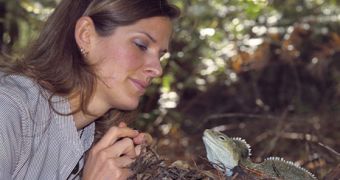The latest technique is used to study perhaps the oldest reptile species on Earth, New Zealand's tuatara, the relict of a group that flourished 200 million years ago.
On Stephens Island in the stormy Cook Strait, a team uses a male that can show physical displays to establish its dominance, only that his skin is rubbery and its energy comes from a nickel-cadmium battery.
"Robo-Ollie" helps postdoctoral student Jennifer Moore to investigate male dominance establishment in these endangered reptiles.
Understanding breeding behaviors could help tuatara translocation and captive-breeding programs, this way conservationists being able to choose the fittest males.
"We needed a model we could manipulate in the field to look at aggression between males, which ultimately leads to reproductive success," Moore said.
"That can give us an idea of who is winning the fights; who's getting the ladies, who's fathering the children-who is more successful, generally."
The robot was developed at Weta Workshops, the Wellington-based animatronics company that delivered the monsters for movies like Lord of the Rings trilogy. The robot was made using as a mold the corpse of a death captive male and is made of a polyurethane cast. Tiny electrical servos control motion that permit Moore to choreograph Robo-Ollie's territorial displays.
"The robot can't walk around; its movement is limited to its head," said Moore.
Still, the robot must be reprogrammed, as for the moment Robo-Ollie inadvertently displays at least one gender-bending trait.
"He bobs his head, which we now know is a female signal, so he's sending mixed messages. We're going to have to tweak things a little bit." said Moore.
"Head bobbing in females is an appeasement gesture, a way of pacifying aggressive males. Ollie should be gaping his mouth, which is a very strong signal from one male to another."
The robot with remote cameras is left alone in the wild for a few hours at a time.
Moore's team spent five weeks in March investigating the reptile's behavior. They found that the wild tuatara are rather curious than aggressive and they developed ritualized pantomime to avoid aggression.
"If one gapes and the other one doesn't gape back, that's the end of it. But if one gapes and the other one gapes back, then the first one puffs up and then the other one puffs up, and it escalates from there. If one doesn't back down, it degenerates into full-on fighting and rolling." said Moore.
"These are animals that spend perhaps 95 % of their time sitting motionless. So if they are forced to do something that requires big bursts of energy, then that's really costly. They often lose Tails in fights, and [regenerating them] can be a big cost, too." she said.
It appeared that only 25 % of the males produce all of Stephen Island's young, usually the largest individuals, which can be up to 90 years old.
"Male tuatara may have one or two partners in a season. On the other side of the coin, females will occasionally mate with more than one male in a season, so there's a lot going on," said Moore.

 14 DAY TRIAL //
14 DAY TRIAL //